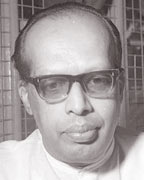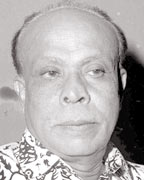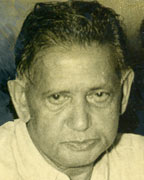|
60th anniversary of 1956 Revolution:
Milestone in nationhood
by Pramod de Silva
Contemporary politics in Sri Lanka is a heady mix of clashing
policies and personalities, but the history of political parties here is
even more fascinating. Rising from the fiery embers of the struggle for
freedom from the British, local political parties had to transform their
agendas to suit a post-independence Sri Lanka.
 |
|
Pix: Transcurrents |
The first political party in Sri Lanka (and now the oldest) is the
Lanka Sama Samaja Party (LSSP) which was established on December 18,
1935. Although its legendary founders including Dr. Colvin R. de Silva,
Dr. N.M. Perera and Philip Gunawardena went on to become political
colossuses later on, it was left for two other parties - the United
National Party (UNP) and the Sri Lanka Freedom Party (SLFP) to emerge to
guide Sri Lanka's post-independence destiny.
The United National Party was founded by D.S. Senanayake in September
1946, just two years before Sri Lanka gained Independence. He became
independent Sri Lanka's (then known as Ceylon) first Prime Minister and
ruled until his death in 1952. The ascension of his son Dudley
Senanayake to the post of Premier and several other policies of the UNP
went against populist sentiments at that time and many felt that there
was a lacuna that could perhaps be exploited by another political force.
This was the seed that sprouted the Sri Lanka Freedom Party, the very
name perhaps reflecting the fact that Sri Lankans were yet to gain
freedom from the colonial mentality. The party was formally founded in
September 1952, by Solomon West Ridgeway Dias (SWRD) Bandaranaike, a UNP
stalwart (and Health and Local Government Minister in the UNP
Government's Cabinet) who became increasingly disillusioned with the
party's actions and course and crossed the floor of the House after
forming the new party. Several other prominent politicians joined his
party, including former Prime Minister D.M. Jayaratne.
 |
|
During the Buddha Jayanthi
celebrations in 1956 Pix: Transcurrents |
The UNP Government faced several challenges including the infamous
hartal of 1953 which led to the resignation of Dudley Senanayake. This
was the perfect backdrop for SWRD to marshal his forces against the
incumbent UNP role. Having already won nine seats in 1952, when
elections were declared for April 5-8, 1956, SWRD lost no time in
forming a broad coalition of forces from the society known as Sangha (Maha
Sangha/Priests/clergy), Guru (teachers), Govi (farmers), Weda
(doctors/physicians) and Kamkaru (working class) with the aim of
toppling the UNP administration headed by Sir John Kotelawela. SWRD and
the other leaders tapped into the heartbeat of a large segment of the
population who had been neglected up to that time.
Pancha Maha Balavegaya
Coincidentally, there was a Buddhist resurgence in view of the Buddha
Jayanthi anniversary in the same year (1956) and there was a convergence
of ideals and forces that focused on regaining the rights of Buddhists.
This gave the Maha Sangha a greater voice in the above mentioned
collective of forces and also led to a call to revive a culture-based on
Buddhist values. The Maha Sangha too began to play a pro-active role in
an advisory capacity, a tradition which continues now.
Known to this day as the Pancha Maha Balavegaya (Five Great Forces)
and formally coming under the banner of Mahajana Eksath Peramuna
(People's United Front), it was one of the most successful political
movements Sri Lanka had ever witnessed. The mostly rural masses
instantly identified with the core aims of the SLFP/MEP 21-point program
to usher in a People's Revolution and give true meaning to the
independence achieved in 1948. With the surge in popularity thus
witnessed by the SLFP across all walks of life and from all corners of
the country, a victory for the SLFP-led coalition was more or less
assured despite the heavy campaigning of the UNP.
This week marks the 60th anniversary of the 1956 Revolution, that
major turning point and paradigm shift in local political history. A lot
of water has passed under the bridge since then, but one cannot
underestimate the influence it had on the local political landscape and
even on our way of life.
Clean break
 |
 |
T.B.
Illangaratne |
Badiuddeen
Mohamed |

Dr.G.P.
Wickramarachchi |

M.W.H.D.
de Silva |
 |
|
T.B. Tennakoon |
The '1956 Revolution' as it is now referred to by politicians and
historians alike was based on a democratic, socialist and nationalist
agenda that took the reactionary class head-on. Externally, Sri Lanka
also took on a non-aligned stance, though the namesake - the Non Aligned
Movement did not take shape until 1961. The 1956 Revolution was seen as
the populace's answer to the Westernised elite class (called Brown
Sahibs by SWRD) who earlier held the reins of power.
It emboldened the Five Great Forces who earlier had little or no say
in the governance process and also led them to think in terms of
socio-economic emancipation. The village was suddenly in the spotlight,
almost the centre of power.
Expectations were high and the 1956 Government (formed on April 12,
1956) led by SWRD as Premier had a lot of work to do, to fulfil the
multitude of promises. Significantly, the 14 ministers of the 1956
Cabinet took oaths in national attire, marking a clean break from the
colonial past. SWRD was also keen to change the Constitution and get
away completely from colonial ties, though this wish would not be
granted until 1972.
The 1956 Government did deliver on many of its promises including
reverting defence facilities in Katunayake and Trincomalee to local
control (they were still held by the British as Ceylon was still a
dominion), lowering the voting age to 18 and enacting the Paddy Lands
Act to uplift local agriculture. The healthcare and education systems
were also improved. Two traditional centres of higher learning -
Vidyalankara and Vidyodaya - were elevated to the status of
universities. Future Governments would improve on those steps.
The very popularity of the Government also meant that it could not
escape the basest of instincts shown by some of the protagonists. One
such decision would haunt Sri Lanka for decades hence, culminating in a
30-year conflict and thousands of deaths on both sides of the ethnic
divide.
The Sinhala Only Act, which essentially declared Sinhala as the only
official language of the country pleased the Sinhalese nationalists but
alienated the Tamil (and Tamil-speaking Muslim) communities. In effect
it drove a wedge between the two main communities.
SWRD was keen to make amends through the Bandaranaike-Chelvanayagam
Pact which was signed to grant equal parity to the Tamil language. It
was bitterly opposed by many sections in the Government and the
Opposition, resulting in a watered-down Act that did little to appease
the Tamil community.
This perhaps marked the beginning of Sri Lanka's slide towards ethnic
strife. In fact, Sri Lanka witnessed communal riots in 1958.
Assassinated
Many were not pleased with SWRD for his stance on the ethnic issue
and many other issues. He eventually had to pay with his life on
September 26, 1959, just three years into his tenure. He was
assassinated at his home by an extremist bhikkhu, plunging the country
into disaster and gloom.
His wife, Sirimavo Bandaranaike was immediately thrust into the
limelight. Although a political novice, she easily won the 1960 General
Election (becoming the world's first woman Prime Minister in the
process) and consolidated on the socialist foundation laid by the 1956
revolution in partnership with other parties such as the LSSP and the
Communist Party of Sri Lanka.
Under her leadership, the SLFP-led Government of 1960-1964
nationalised key sectors of the economy such as banking and insurance,
bus services and took over schools owned by the Catholic Church and
private institutions. The nationalisation of many enterprises angered
foreign powers. The setting up of the People's Bank to complement the
Bank of Ceylon was another key initiative.
Her Government survived a coup attempt in 1962, whose perpetrators
were caught and punished. This was in effect a counter-response to the
socialist initiatives taken by the Sirimavo Bandaranaike Government. She
would once again lead the country from 1970-1977, continuing much the
same policies and achieving greater status in the International
Community.
A little mentioned result of the 1956 Revolution, was the effect it
had on the officialdom which consisted primarily of the English-educated
class in 1956. As the rulers strove to build a bureaucracy that was more
in tune with the aspirations of the people, the officials had to change
their ways.
As the years went by, the Administrative Service saw a complete
transformation, as more people educated in the vernacular languages at
Government schools entered the service with a true understanding of what
it is like to be from the ordinary class. The 1956 Revolution
transformed not just the bureaucracy, but also education, health,
transport and a multitude of other sectors. The 1956 Revolution, later
described by veteran author Martin Wickramasinghe as the 'fall of the
Brahmin regime' reverberates in Sri Lanka's socio-political milieu to
this day. The era of the common man had well and truly arrived.
This essentially silent revolution had both positives and negatives,
but it can be termed as one of the most significant events in
post-independence history, becoming the essential bedrock on which
almost all Governments have broadly based their policies in the years
hence. |

